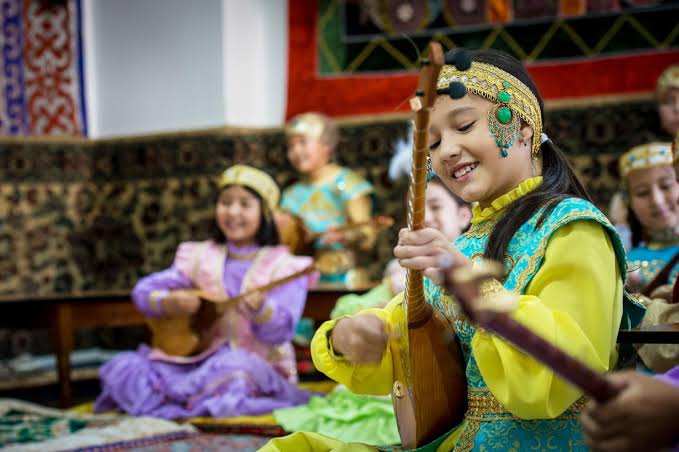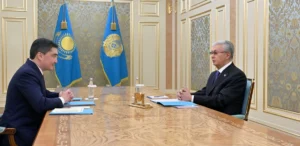Evolution of Kazakh Musical Art and National Concept in Modern Composer Creativity

The kuy, a main genre of Kazakh national music, exemplifies the evolution and dissemination of traditional music. The process of exploring national art has revealed a “distancing” from original sources in terms of timbre, rhythm, meter, structure, performance, and creative features. This evolution requires a reassessment and revival of forgotten or overlooked phenomena in the national musical heritage. An example is the creative work of Abai Kunanbayev, a Kazakh philosopher, poet, and composer, whose contributions to the golden fund of national musical culture are being re-examined to confirm authorship and musical originality.
Abai Kunanbayev’s Kuy
The renaissance of Abai’s kuy in the era of globalization involves detailed musicological analysis to confirm their originality. B.G. Erzakovich’s work highlights the need for recording and analyzing a substantial number of kuys attributed to Abai. The integration of elements from Abai’s songs and kuys reveals a unique composer’s style, reflecting the structural and artistic essence of Kazakh traditions. The kuy “Mai Tuni,” for instance, showcases the beauty of nature through its melody, indicative of Abai’s style and thematic continuity with his songs.
Ahmet Zhubanov’s observations further illustrate how Abai’s music integrates Kazakh folk traditions with motifs and elements from Russian songs, expanding the musical vocabulary. This blend of influences is evident in the rhythmic and melodic structures of Abai’s compositions. The younger generation’s interest in Abai’s kuy signifies a continued connection to this rich musical heritage, ensuring its transmission and adaptation in modern contexts.
Kazakh Folklore Heritage and Modern Reinterpretation
The song folklore heritage of the Kazakhs, characterized by a wide range of topics and content, encapsulates various aspects of life, social relations, and human emotions. These folk songs convey moral and ethical attitudes, aesthetic values, and human feelings, making them a significant part of the cultural fabric (Albekov et al., 2017). In the modern context, these songs and kuy are being reinterpreted and gaining a “second life,” highlighting the enduring relevance of traditional music.
Composers’ Interpretations of Traditional Music
Modern Kazakh composers such as B. Amanzhol, A. Bestybaev, B. Daldenbay, A. Mambetov, and A. Tolykbayev have creatively reinterpreted bright samples of Kazakh folk and national-professional musical creativity. They build on the experience of predecessor composers, re-intonating well-known traditional songs and kuy. For instance, “Kamajay,” “BalHadisha” by Akhanaseri, and “AinamKoz” by Mukhit have been subjects of modern reinterpretation, blending historical and contemporary elements.
Piano Transcriptions and Re-intonations
The piano transcriptions of traditional Kazakh songs reflect the composers’ creative interpretations. The multiple transcriptions of “Kamajay” by V. Velikanov, B. Erzakovich, N. Mendygaliyev, and A. Bestybaev illustrate the composers’ unique hearing and interpretation. Similarly, the re-intonations of “BirBala” by B. Yerzakovich, V. Velikanov, and A. Tolykbayev, and “Yapurai” by B. Yerzakovich and A. Tolykbayev, demonstrate the evolution of traditional music in contemporary settings.
Double Hearing Phenomenon
The concept of “double hearing,” where different composers interpret the same text or melody in diverse ways, enriches the understanding of traditional music. This phenomenon is evident in the works of E.G. Brusilovsky, Dm.Dm. Matsutsin, and others who have provided different instrumental versions of well-known folk songs like “Karatorgay” and “BalHadisha.” This multiplicity allows for a meaningful comparison of various composer decisions, reflecting historical and retrospective aspects.
Historical and National Traditions
The importance of history and national traditions as a platform connecting the past, present, and future is emphasized by Nursultan Nazarbayev (2017). This connection is crucial for the self-determination of a nation on the global stage through its cultural achievements. The study of the national concept in contemporary composer creativity, especially in relation to folklore, highlights the ongoing relevance and transformation of traditional music in modern contexts.
Reviving Forgotten Traditions
Reviving forgotten and unrevealed phenomena in traditional musical heritage is essential. The works of professional composers from the 20th century, often stored in archival collections, need to be revisited and incorporated into research. This revival not only enriches the cultural heritage but also offers a broader theoretical context for understanding the evolution of musical art in Kazakhstan.
National Origins of Rock-Pop Culture
Kazakhstan’s independence era marked significant developments in the field of musical art, including the creation of various rock and pop bands. These groups synthesized European styles with rich national origins, reflecting Kazakhstan’s inclusion in global processes. The reliance on traditional music, especially folklore and oral-professional traditions, has determined the originality and identity of Kazakh pop music, even in the era of globalization.
Traditional Pop and Modern Styles
Traditional pop music, with its primary genre being the song, remains highly relevant. Kazakh traditional music’s song genre occupies a fundamental place, with compositions allowing performers to showcase their vocal abilities. Modern songs, influenced by traditional genres, also cater to entertainment events, demonstrating the fusion of traditional and contemporary elements.
Ritual Songs and Modern Performances
Ritual songs like “Jar-jar,” “Betashar,” and “Syńsý” associated with wedding rituals have undergone transformations in the modern era. While these songs once had specific ritual functions, they now hold artistic and aesthetic meanings, reflecting changes in performance forms, content, and functions. Modern compositions like “Aqkelin” by Gauhar Alimbekova exemplify this transformation, blending traditional themes with contemporary interpretations.
Conclusion
Musical art, deeply rooted in tradition, plays a crucial role in preserving cultural identity amidst globalization. The examination of traditional music, like the Kazakh kuy, presents its evolving nature and its ability to adapt while maintaining core cultural values. By revisiting and revitalizing ancestral musical traditions, societies can resist cultural assimilation and draw strength from their roots, ensuring the longevity and relevance of their national heritage. The national concept in modern composer creativity reflects a dynamic interplay between traditional music and contemporary reinterpretations. By re-intonating and reviving traditional songs and kuy, modern composers preserve and transform cultural heritage, ensuring its relevance in the global context. This creative process highlights the importance of historical and national traditions, providing a rich foundation for the evolution of Kazakhstan’s musical art.


